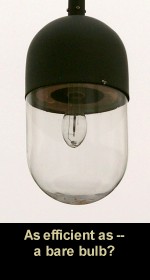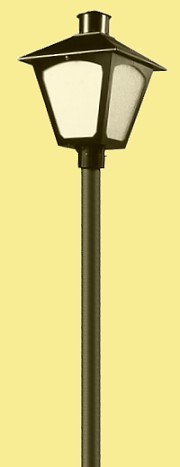Working toward legislation to curb light pollution in Illinois.
1. "The most energy-efficient luminaire is a bare lamp."
In outdoor illumination there has, to the best of our research, NEVER been any standard which suggests that all light emitted in any/all directions should be included in efficacy consideration. Outdoors, lacking the enclosure of ceiling and walls, a target area for illumination must be defined. This is normally an area of ground, generally beneath and/or adjacent to the luminaire mounting position. A bare lamp outside, therefore, wastes most of its output in the wrong directions. Adding a simple reflector above it re-directs some of that un-aimed output down to the target area; adding well engineered optics can increase the energy efficiency much more. 2. "Well-aimed luminaries can't be energy-efficient; energy-efficient luminaries can't be well-aimed"This actually may be true-- WITHIN A PARTICULAR MANUFACTURER'S PRODUCT CATALOG. As far as laws of physics and optics are concerned, it is false. It is quite possible, with current technology, to design luminaires which focus a high percentage of their lamp's total light output on a well-defined target area. If a particular manufacturer has chosen to design to goals other than these, their product line may not include any luminaires which meet even moderate standards of both aiming and efficiency. Or, they may have a few "token" models which aim at either light control (such as limiting uplight, which has been demanded by the dark sky community), or energy efficacy, but without a concerted focus on both issues, results will be less than what we need to achieve for truly responsible, sustainable outdoor lighting. 3. "Installing well-aimed luminaires requires using more fixtures in a given area than would be needed using luminaires which create stray light."This "tale" is much like #2, above. If a given manufacturer's offerings are short on well-aimed luminaires, then one cannot necessarily expect to be able to design an installation which limits stray light using a minimum number of their luminaires.  But again, no laws of physics or geometry require that more luminaires are needed if they are well-aimed. Very few luminaires of any design can provide useful, uniform illumination to a target area which extends to four mounting-heights away from their position. (Indeed, most only cover an area of only 1.5 to 3 mounting heights in radius with adequately uniform light; where have you seen area installations of any sort where the lampposts were as far as eight of their heights apart?) A luminaire can have a cutoff line 14 degrees below the horizontal, and illuminate out to four mounting heights. 4. "Installing well-aimed luminaires creates more uplight from reflection off the ground than using less efficient luminaires would."The amount of light reflected off the ground and other surfaces is directly proportional to the intensity of the light shining onto those surfaces. The design goal for any area to be illuminated should be to bring that area up to a specific level of illumination. If using more efficient luminaires makes the area brighter than the target level (brighter than it would be using less efficient luminaires), simply reduce the wattage of lamps used to bring the illumination level back down to the target values. (After all, using more efficient fixtures should reduce energy consumption, shouldn't it?) 5. "A streetlight or area light must shine light into the glare and uplight zones to be efficient."This statement echoes Number 2, above. When lighting manufacturers set out to design luminaires to illuminate as wide a target area as possible (a common goal), if their design parameters do not also include the goal of reducing stray light, it has been common for them to end up with models which create stray light. But again, there are no laws of physics, optics, or geometry which prevent the creation of luminaires which do a superior job of putting their light output where it belongs. Indeed, all stray light is wasted energy, and represents a reduction in energy efficiency. 6. "A streetlight is a streetlight; don't worry about technical details-- daytime appearance is all that matters to the customer."This line is, unfortunately, too easy to sell to many end-use decision makers. It has also spawned a large percentage of the massive energy waste and environmental disruption which goes on every second of every night, all across this country and others. Streetlights operate for thousands of hours each year, multiplied by the tens, hundreds, or thousands in each installation. The difference between 10 or 20% efficiency and 60 or 70% efficiency in those cases can equal an immense difference in the amount of electricity consumed. And most streetlight installations remain for 25-50 years-- a long period to have either a large or reduced energy demand.
- FOOTNOTE: If any of the terminology on this page is confusing, please see the definitions on our Encyclopedia of Terms page. |
Return to Page TopThis page available as an Adobe Acrobat document Here |
|||
light pollution Illinois Chicago Cook County DuPage County Will County Springfield energy enviromnent global warming anti light pollution legislation lighting ordinances |
|||


 In indoor illumination, all the light which escapes a luminaire is considered to be useful. The underlying concept is that enclosed by a ceiling and walls, light reflects within a space to create effective ambient illumination. So, in indoor efficacy rating, a bare lamp does indeed have the highest luminaire efficacy (although the lighting designer is aware that glare from a bare lamp will likely reduce visual perception, and therefore, diffusing the light will usually achieve the highest functional energy efficiency).
In indoor illumination, all the light which escapes a luminaire is considered to be useful. The underlying concept is that enclosed by a ceiling and walls, light reflects within a space to create effective ambient illumination. So, in indoor efficacy rating, a bare lamp does indeed have the highest luminaire efficacy (although the lighting designer is aware that glare from a bare lamp will likely reduce visual perception, and therefore, diffusing the light will usually achieve the highest functional energy efficiency). Take, for example, this charming coach-lamp styled luminaire. It is designed to evoke a nostalgic feel; the municipal leader will envision how charming it would look, installed all up and down Main Street. Sold! But, let's look "behind the scenes" at the technicalities (which the salesperson may be hesitant to share): The luminaire features a 150-watt high pressure sodium lamp. This lamp generates 106 lumens of visible light per watt of electricity consumed (106 lumens/watt is a respectable value, as far as energy efficiency is concerned). But how efficient is the whole luminaire at turning electricity into useful illumination? That value is measured by the Target Efficacy Rating: include only the lumens of light which reach the target area under and around the installed luminaire in the efficiency calculation. The results, for this "modern" coach light? Nine (9) lumens per watt. Yes, less than 10% of the light created by the lamp is getting where the illumination is needed; an almost unbelievably low efficiency performance. Luminaires with a TER of just 50 lumens/watt could illuminate Main Street to the same level using one-fifth the electricity, night after night, year after year.
Take, for example, this charming coach-lamp styled luminaire. It is designed to evoke a nostalgic feel; the municipal leader will envision how charming it would look, installed all up and down Main Street. Sold! But, let's look "behind the scenes" at the technicalities (which the salesperson may be hesitant to share): The luminaire features a 150-watt high pressure sodium lamp. This lamp generates 106 lumens of visible light per watt of electricity consumed (106 lumens/watt is a respectable value, as far as energy efficiency is concerned). But how efficient is the whole luminaire at turning electricity into useful illumination? That value is measured by the Target Efficacy Rating: include only the lumens of light which reach the target area under and around the installed luminaire in the efficiency calculation. The results, for this "modern" coach light? Nine (9) lumens per watt. Yes, less than 10% of the light created by the lamp is getting where the illumination is needed; an almost unbelievably low efficiency performance. Luminaires with a TER of just 50 lumens/watt could illuminate Main Street to the same level using one-fifth the electricity, night after night, year after year.